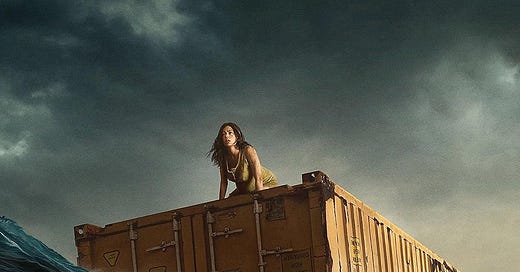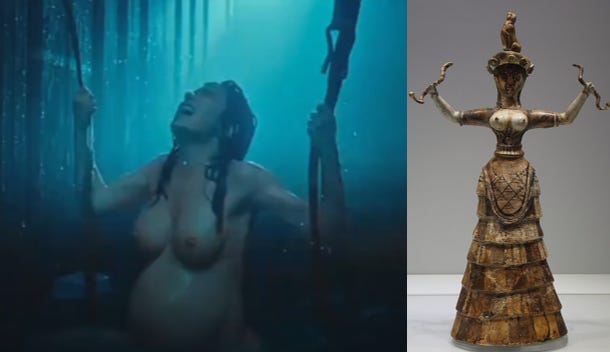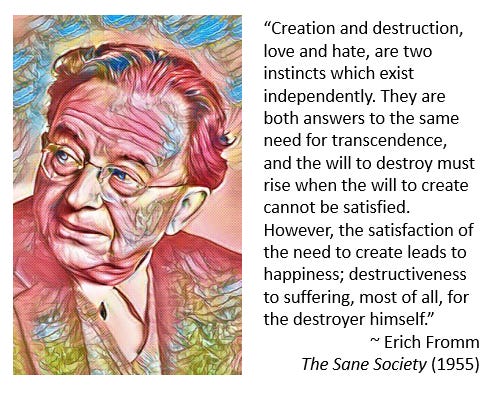Waterbirth at Sea: Pregnancy, a Power Drill, and Transcendence in the Middle of "Nowhere"
An exploration of the 2023 dystopian film, "Nowhere," and its unique representation of human transcendence
Over the years I've extensively researched and written on the representation of pregnancy and childbirth in popular culture. Often women's childbirth experiences are stereotyped in very narrow and dehumanizing ways. In film, for example, women are almost always shown to be imperiled whenever they go into labor. And they usually need someone to rescue them. This is to say nothing of the perfunctory depiction of childbirth as a medicalized event inextricably tethered to the hospital as opposed to the home or a birth center.
Movies and TV shows rarely represent childbirth as a humanizing or empowering experience. Often enough, women’s birth labor occurs out of sight and offscreen in those stories where birth is relevant to the plot, pushing a truly priceless and invaluable labor to the background of our consciousness. And this is why the Spanish film, Nowhere (2023), is so impressive.
The film is set in a dystopic future where a totalitarian government has taken control of Spain. The government responds to a lack of vital resources by systematically killing civilians. Women, children, and the aged are particularly targeted. The film begins with protagonists Mia, who is pregnant, and her husband Nico trying to evade government forces as they round up targeted citizens. The couple paid to be smuggled out of the country, but their smugglers are motivated by remuneration, not empathetic concern. They forcefully herd their clients through perilous checkpoints, prodding them as though like they were cattle in unsympathetic efforts to evade meat packers.
Mia, who is nearing the end of her pregnancy, and her affectionate husband, Nico, make it to their desired destination: a shipping container bound for another country out of the grips of the dictatorship. Nico celebrates their progress by bestowing a candy bar upon his beloved. Something to save for later. Circumstances quickly change for the worse when unauthorized passengers overrun the container. Nico is swept up among those violently forced out by the smugglers and forced to board a different shipping container, leaving the couple distressingly separated. From there on out, Mia is without Nico's loving and optimistic support. She goes on to face one harrowing challenge after another, relying on nothing but her own ingenuity and instinct for survival.
The film is beautifully sparse and riveting from start to finish. More than one hour of the 109 minute film takes place inside or on top of Mia’s shipping container. This is not the kind of dystopian-disaster film that focuses on solving the macro level problem at hand. By the end of the movie we’ve learned nothing of the future of the Spanish totalitarian situation nor have we learned how the country fell prey to authoritarianism in the first place. Instead, we are zoomed in on one person's struggle to survive even as she is inundated with injustice, personal loss, material depredation, and an existential crisis of whether or not to go on with the struggle of life.
Amidst the chaos Mia chooses not to give in to defeatism and death, and to birth and care for her infant. And it is here that Nowhere makes such an inspiring and unique impact. The film unites two domains of existence that are often treated as polarities: caretaking (domestic) and “bread winning” (public). Mia is equal parts mother and survivalist-provider, with the two shown to be complimentary rather than at odds or belonging to one or another sex. She seamlessly alternates between breastfeeding, power drilling, and repurposing plastic containers (“Tupperware”) in Macgyver-esque fashion to catch water, plug up leaks, and to create a fishing net. (She discovers that baby poop makes for great fish bait!)
Throughout the film Mia subverts stereotypical femininity in deed rather than word or ostentatious pronouncement. What’s more she does so without embracing the all-too-common faux liberation from sexist stereotypes in which a female character is shown to be “more” than just a woman by adopting androcentric-patriarchal norms of respectability at the expense of explicit identification with femaleness. Mia’s womanhood is consistently affirmed throughout the film, and so, too, is a humanity that defies stereotyping.
Waist Deep: Mia’s Waterbirth
As alluded to earlier, Nowhere’s birth scene is a cinematic feat. Mia gives birth without assistance while marooned at sea in a shipping container. But we do not pity her as she triumphantly activates her (pro)creative powers. She exemplifies something of the divinity our ancestors likely had in mind when they carved the Venus of Willendorf out of limestone some 28,000 years ago.
The only other fictitious cinematic representation of childbirth that I'm aware of approaching this one is featured in A Quiet Place (2018). In that film, the protagonist, Evelyn, played by Emily Blunt, gives birth unassisted, alone, and in complete silence as lethal alien monsters prowl nearby. It's a lengthy scene that is equal parts terrifying and breathtakingly badass.
Mia, the mother in Nowhere, played by Anna Castillo, is anything but silent during her onscreen birth-work, a scene that runs a full two-minutes long. Rather than contending with murderous aliens, Mia confronts wild and inhospitable natural elements as her steel vessel is turbulently tossed about the ocean during a lightening infused tempest. And she does so with a guttural feminine roar. One that manages to confound the conventional representation of femininity and childbirth. She does not call for a doctor or anyone to “coach” her through labor pains; she summons her own maternal resilience.
Standing in waist-deep water, Mia strips off her dress and firmly grasps the two straps hanging from the top of the shipping container, one in each of hand. She enters a primal state of potent readiness for her birth-work. It’s worth noting the filmmakers do not pornographically linger over her body. Her breasts are not displayed for titillation and her body is not void of agency. The sexist conventions sociologist Erving Goffman identified in advertisement representations of femininity, in which women are shown to be inactive, leaning, recumbent, self-touching, and infantile, are instantly overturned. We are no more inclined to sexualize Mia, as she calls forth the uniquely feminine powers of life-creation, than the Minoans were inclined to sexualize the Snake Goddess.
We are instead invited to observe Mia in empathetic awe as she delivers her own creation in what is probably the most dramatic waterbirths in movie history. Her birth experience is not pleasant or easy. But it is an accomplishment of perseverance and transcendence in the sense of literally creating not just something but someone new beyond the self.
That Nowhere represents creative transcendence is no small matter. Popular media is saturated with glamorized depictions of domination and destruction, particularly when it comes to action and disaster-oriented stories. Strangely, creativity and destruction are two-sides of the same human striving to overcome passivity and meaninglessness. In The Sane Society (1955), Erich Fromm explained that human beings, though “thrown into this world” without our “knowledge, consent or will,” are “driven by the urge to transcend the role of the creature, the accidentalness and passivity” of our existence through transcendence.
One option available to us for this self-assertion is creativity, be it through the literal creation of life unique to women or the creativity of participating in agriculture or human cultural works. Fromm wrote,
“In the act of creation man transcends himself as a creature, raises himself beyond the passivity and accidentalness of his existence into the realm of purposefulness and freedom.”
The other, too often embraced by (many though certainly not all) men is destruction. As Fromm explained it:
“In the act of destruction, man sets himself above life; he transcends himself as a creature. Thus the ultimate choice for man, inasmuch as he is driven to transcend himself is to create or to destroy, to love or to hate….
“Creation and destruction, love and hate, are two instincts which exist independently. They are both answers to the same need for transcendence, and the will to destroy must rise when the will to create cannot be satisfied. However, the satisfaction of the need to create leads to happiness; destructiveness to suffering, most of all, for the destroyer himself.”
What makes a film like Nowhere particularly significant is the time it carves out to represent creative transcendence rather than destructive transcendence. More specifically, the lengthy representation of women’s creative birth-work and caretaking work pushes back against the popular cultural tendency to ignore or diminish the creative and frequently exploited labors of mothering. (We were treated to a clear instance of this denial of respect for women’s birth-work and agency when Bruce Perreault, in episode of five of the 45th season of Survivor, scoffed at learning women sometimes received “push presents” after giving birth. “Presents now for pushing out a baby?” He scornfully declared that the child was all the present women deserved.)
Representations of creative transcendence such as that depicted in Nowhere are also significant because they offer a unique alternative to the conventional narrative in which the story centers on responding to one form of destructiveness—an invasion of evil aliens, the rise of an evil dictatorship—with yet another form of destructiveness—killing the evil aliens or violently overthrowing the dictatorship. That destruction is sometimes necessary is one thing; that it is invited to stand at the center of our adventurous and dramatic narratives of life, above and with greater fanfare than life-affirming and nurturing creativity, is quite another matter. In place of such storylines, Nowhere (and A Quiet Place), make significant space to highlight the prospects of achieving transcendence—be it the transcendence of adversity or disaster or the transcendence of human accidentalness—through creativity and love. Such stories are worth telling again and again.
Those who found this piece of interest may appreciate the two articles below.
If you enjoyed this post please share it with others and like it by clicking the heart icon. Be sure to subscribe if you haven’t already.
Invite Dr. Nall to Speak
Dr. Nall delivers energetic live presentations and engaging workshops on the subjects featured in Humanities in Revolt. Those interested in booking a workshop or talk can get in touch through Facebook or by leaving a comment.










